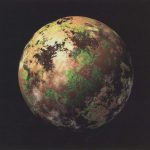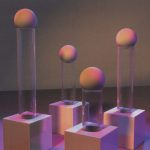Bruce Wands
Art Works:
-

The Earth is Art
Categories: [2D & Wall-Hung]
[SIGGRAPH 2003] -

Variations 703
Categories: [Installation] [Interactive & Monitor-Based]
[SIGGRAPH 2003]
Writings and Presentations:
-
Title:
Beyond Brush and Easel: The Computer Art of Charles A. Csuri from 1963 to present
Writing Type: Panel / Roundtable
Author(s):
Exhibition: SIGGRAPH 2006: Intersections
Abstract Summary:This panel explores the computer art of Charles A. Csuri, an artist, recognized by Smithsonian Magazine as “the father of digital art and animation,” and includes discussion of his works from 1963 to the present. In this rare opportunity, we will also hear reflections from the pioneering artist himself, now Professor Emeritus and Artist in Residence at The Ohio State University. This art panel is presented in conjunction with the retrospective exhibition, Charles A. Csuri: Beyond Boundaries, 196
Title: Thoughts on Hesse, Digital A and Visual Music
Writing Type: Essay
Author(s):
Exhibition: SIGGRAPH 2004: Synaesthesia
Abstract Summary:This essay describes the influence of Hermann Hesse’s ideas on my creative work and how I create interactive music sculptures and visual music. In his book, Magister Ludi, Hesse describes a game in which art and music blend together in a way that allows for transformation of creative content into various forms of media. “Variations” is an ongoing exploration of interactive sculpture and visual music that began in 1999 and still continues. The following describes my thought process for early versions of this work, as well as for “Variations 03,” an interactive music installation that was exhibited as part of the SIGGRAPH 2003 A Gallery. My approach in creating this work was to develop a three-dimensional sound matrix that viewers could change as they interacted with the sculpture.
[Download PDF]
Title: The Digital Becomes Contemporary
Writing Type: Essay
Author(s):
Exhibition: SIGGRAPH 2003: CG03: Computer Graphics 2003
Abstract Summary:We are at a special and paradoxical moment in the development of digital art. Now that it is finally gaining widespread public and critical attention, digital art is also being quickly absorbed into the world of contemporary art. The next generation of artists and critics will not look at making art with a computer as something extraordinary or unusual. This phenomenon is already quite apparent in galleries in New York and abroad. While galleries like Postmasters and Bitforms specialize in new-media art, numerous other galleries in Chelsea exhibit similar work, but do not make the distinction that it is new-media art. Another growing trend in New York is for artists to display prints along with new media as an integral part of the exhibition. The return to the object is due in part to the recent widespread availability of archival printing methods. Museums are also in the process of refitting to accommodate the next wave of contemporary art. The Museum of Modern Art in New York has closed for two years to update its galleries, and the Stedelijk Museum of Modern Art in Amsterdam is planning a major renovation for 2004. For those of us who have followed the SIGGRAPH Art Gallery for many years, this acceptance of digital art by the contemporary art world is refreshing, but also raises many questions. Digital art has operated outside the art establishment for many years, and this has allowed it to remain relatively free.
[Download PDF]
Role(s):




